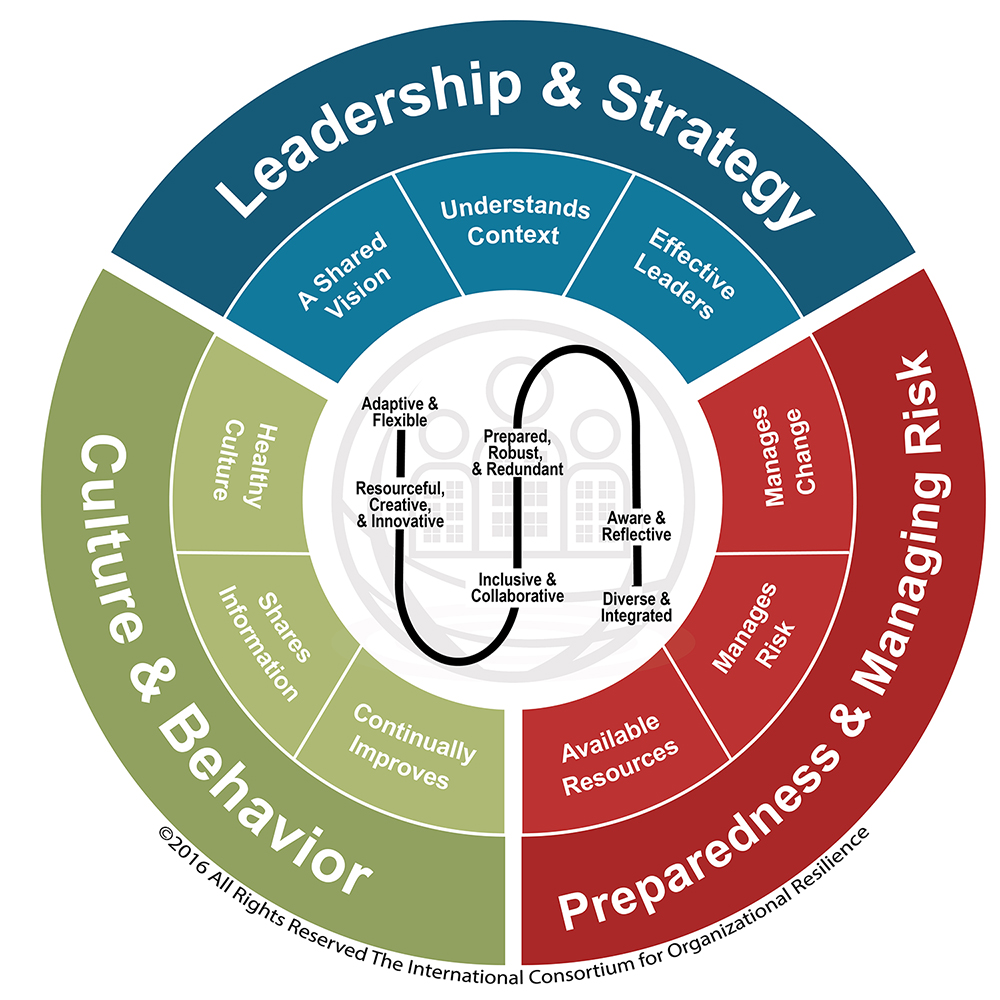
The Model for Increasing Organizational Resilience is based on ISO 22316: Security and Resilience – Organizational Resilience Principles and Attributes.
The Organizational Resilience Model is comprised of 3 Dimensions, 9 Strategies, and 6 Behaviors.
Each organization is unique. The way organizational resilience is implemented is also unique, however studies have shown that there are common attributes and behaviors demonstrated by organizations that have survived and thrived during times of change and uncertainty.
Contact us to donate or share a resource that supports the Organizational Resilience Model.
3 Dimensions: The 3 Dimensions are each comprised of 3 strategies that can be implemented to increase the resilience of an organization.
9 Strategies: Each strategy can be implemented on its own or in combination as part of the overall organizational resilience strategy.
6 Behaviors: The identified behaviors describe how more resilient organizations behave. These behaviors are considered to be important in preventing breakdown or failure; or enabling appropriate and timely action to be taken. They distinguish a more resilient organization from one that is simply well-run, successful, or prosperous.
1. Leadership & Strategy
Organizational resilience is increased and enhanced when the organization demonstrates leadership qualities and intentionally implements strategies.- A Shared Vision: The members/employees of the organization clearly understand the purpose, vision, and values of the organization.
- Understands Context: There is a comprehensive understanding of both the internal and external dimensions of the organization.
- Effective Leaders: Leaders are effective and empowered, are trusted and respected, and leadership is distributed throughout the organization.
2. Culture & Behaviors
Organizational resilience is increased and enhanced when there is an intentional effort to ensure a healthy culture throughout the organization.- Healthy Culture: The existence of core values and behaviors that support the health and welfare of its members/employees, foster creativity and empower members/employees to communicate effectively.
- Shares Information: Information and knowledge is shared to enable effective decision-making, learning from experience and from others is encouraged and valued, and is recognized as a critical resource of the organization.
- Continually Improves: Performance is continually monitored and a culture of continual improvement is encouraged.
3. Preparedness & Managing Risk
Organizational resilience is increased and enhanced when the organization intentionally manages risk and prepares for the unexpected.- Available Resources: Resources are adequate and available when needed in order to provide the ability to adapt to changing circumstances.
- Manages Risk: Risk is managed throughout the organization and the use of management systems used as appropriate.
- Manages Change: Ability to anticipate, plan, and respond to changing circumstances and incidents.
6 Behaviors
Adaptive and Flexible
The organization is accepting of ever-increasing uncertainty and change. The organization and its people have the ability to change, evolve, and adapt in response to changing circumstances and the ability to apply existing resources to new purposes. Mechanisms exist to continuously evolve and the organization is able to modify its activities rather than seeking solutions based on the status quo.
Resourceful, Creative & Innovative
The organization and its people are able to rapidly find different ways to achieve their goals or meet their needs under changing circumstances. They are able to transcend traditional ideas, roles, and patterns to create something new by using originality of thought and demonstrating imagination. The organization fosters creativity and innovation by seeking out and promoting new and innovative ideas to achieve its objectives.
Inclusive & Collaborative
The organization seeks collaboration with and engagement of its interested parties to enable working together towards a common purpose or goal. The inclusion of its people in the collaboration results in a sense of shared ownership or a joint vision to build resilience.
Prepared, Robust & Redundant
Intentional actions exist to work out the details of a plan of action in advance of it being needed. Robust systems are well-conceived, constructed, and managed so they can withstand significant impacts without damage or loss of function. Spare capacity is purposely created within systems so that they can withstand disruption, extreme pressure, or surge in demand.
Aware & Reflective
The organization has the capacity to anticipate future conditions through situational awareness, horizon-scanning, and information gathering. The organization and its people learn from past experiences to leverage this learning and inform future decision-making. The awareness and reflective nature increases the organization’s ability to think beyond its current activities, strategy, and organizational boundaries.
Diverse & Integrated
The organization recognizes the importance of the diverse nature and characteristics of its people. This includes a range of capabilities, information sources, and technical elements. Diversity is best implemented when there exists the opportunity to bring together disparate thoughts and strategies into cohesive solutions and actions. This includes the intentional horizontal and vertical integration of the working environment.